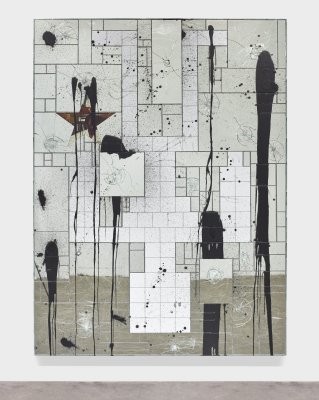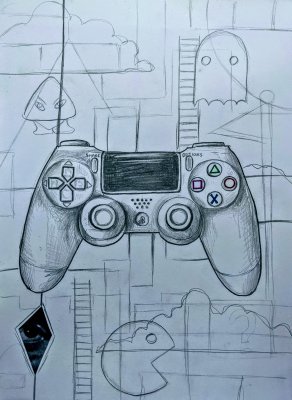Materials
- Drawing paper
- Pencil or pen
- Photographs (or magazines)
- Scissors
- Glue
- Yoga mat or sturdy blanket
- Colored pencils or markers (optional)
Vocabulary
Identity in art: the way an artist perceives or expresses themselves within their artwork, often by questioning, exploring, and expressing
Discussion and Video
Begin by using the Teaching Tips and Tools for Discussion or ask your students to self-guide themselves using the Tools for Looking at an Artwork. An example of how to bring in information about the artist from something your student observes: They may notice that the cracks in the glass look similar to how bullet holes may look. You can share that the artist is bringing notions of violence against the African-American community into his artwork. You might want to ask your students how that makes them feel and why they think the artist thought it was important to add that element to his work.
Next, watch the following video:
Begin a discussion with your students by asking the following questions:
- Johnson mentioned that he was using movement as a way to de-stress. What are your ways of releasing stress? Have you tried using movement? Was that a successful method? Why or why not?
- Do you think there is a connection between physical movement and visual art? Why or why not?
- Why do you think it is important to Johnson to use actual objects in his works instead of just re-creating them through drawing or painting?
Movement
In the video above, Johnson mentioned how he included a rug in one of his installations so that the viewer could imagine themselves moving with the video. Explain to your students that they are going to take time to do some movement before they begin creating an artwork.
Ask your students to lay out a yoga mat or a blanket in an area where they have room to move. Lead your students in a movement exercise including poses that are high and low, as well as slow and fast, then ask them to jump to mimic the movement that inspired Johnson for his New Black Yoga video piece. (If you would prefer for your students to watch a video, look for one that includes yoga, tai chi, dance, etc.)
After they have finished a few minutes of movement, have them sit quietly and take a few deep breaths. Ask them to think of an object that represents them and to take a few moments to concentrate on that object.
Artmaking
Overview: In this project, students will explore how to express their identity through multiple ways of artmaking, taking inspiration from Rashid Johnson’s Falling Man, 2015.
- First, ask your students to write down the object that they thought of during their movement exercise and then write a brief description of why. Students should then draw that object on a sheet of paper. Encourage them to use shading and texture to give the object three-dimensionality.
- Next, ask them to find a photograph (or cut a picture from a magazine) of a place, a person, or an object that represents them. Rashid Johnson added a photograph of his father, which was taken around the time of Johnson’s birth, and then made it into a star for his work. Encourage your students to cut their image into a shape and glue it to their drawing.
- Lastly, ask them to add some additional lines and shapes to fill in the page. Bring them back to how they felt during the movement exercise. Perhaps they can do a repeating pattern, or multiple lines that curve, or some other type of design that represents them. Ask them to think about things that they find meaningful, such as sports, music, crafting, video gaming, etc.
- They can add color, but it is not necessary for this project.

